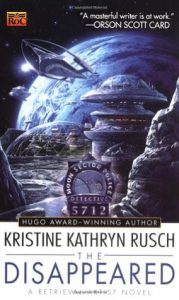Kristine Kathryn Rusch is a Hugo Award winning author born in 1960. She also worked as the editor of The Magazine of Fantasy and Science fiction for a few years and writes in a variety of genres under several pseudonyms. For the Green Hand book project, I read her novel “The Disappeared”, published in 2002, which is part of a 15-book series called the Retrieval Artist series.

I was recommended this book because I was interested in worldbuilding and the idea of how different species might imagine coexisting together, which this book accomplishes in a futuristic setting where humans interact with multiple alien races as part of an “Earth Alliance”. Between the different species, there is an agreement to respect each others’ laws, although breaking these alien laws can bring unjust punishments, including giving away your first-born or being abducted to a hard labor camp.
There are a variety of fun technological novums in this book, some not too unlike the ones we have encountered with other texts, such as Shakespeare holofilms, an almost personified house security system (“House” referred to with a capital H), portals, spaceships, building materials like “moon adobe” and the like. What I found most intriguing how Earth seemed to be presented as a haven of antiquity. For example, flying cars being banned in certain settlements because they would obstruct the view. I was also intrigued by how outer space earthling settlements were named after historical figures of space travel (Gagarin Dome, Armstrong Dome, etc.)
The plot of the novel could well be described as an outer-space cop drama. It follows Miles Finch, whose job it is to retrieve folks who are on the run. Much of the novel is involved in Miles tackling dichotomies between Law and Justice, reminding me a lot of Javert from Les Miserables. There is quite a bit of intrigue and mystery in the text, which, coupled with an exploration of how humans might interact with aliens on a political level makes “The Disappeared” a very compelling read. If you liked Blade Runner, chances are you will really love this book too.
